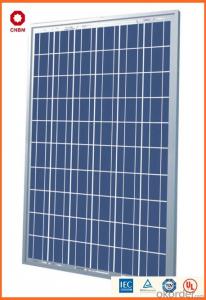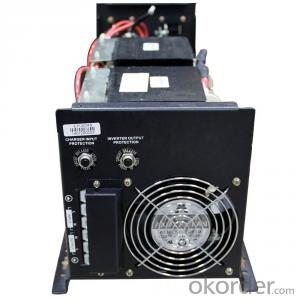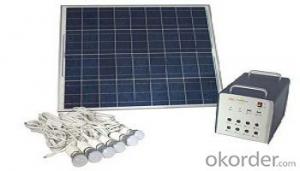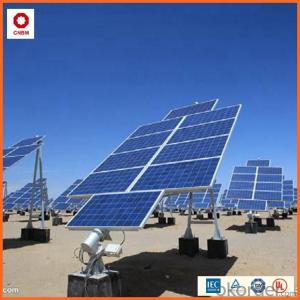Solar Energy Systems:!!! Hot on Sale!!! Stock 265W Poly Solar Panel USD0.45/W A Grade Good Solar Panel
- Loading Port:
- China main port
- Payment Terms:
- TT OR LC
- Min Order Qty:
- 1 watt
- Supply Capability:
- 10000000 watt/month
OKorder Service Pledge
OKorder Financial Service
You Might Also Like
Product Description:
Hot Sale !!! Quality and Safety of 245w-320w Poly Solar Panel
1. Rigorous quality control meets the highest international standards.
2. High-transmissivity low-iron tempered glass, strong aluminium frame.
3. Using UV-resistant silicon.
4. IS09001/14001/CE/TUV/UL
Warranties of 245w-320w Poly Solar Panel
1. 10 years limited product warranty
2. 15 years at 90% of the minimal rated power output
3. 25 years at 80% of the minimal rated power output
Technical date of 245w-320w Poly Solar Panel
ITEM NO.: | Mono 125*125 cell ,36pcs . Power range from 80Wp-100Wp | ||||||||
Maximum Power(W) | 80 | 85 | 90 | 95 | 100 | ||||
Optimum Power Voltage(Vmp) | 17.81 | 17.89 | 17.94 | 17.99 | 18.06 | ||||
Optimum Operatige Current(Imp) | 4.78 | 4.91 | 5.12 | 5.35 | 5.59 | ||||
Open Circuit Voltage(Voc) | 21.98 | 22.05 | 22.14 | 22.28 | 22.45 | ||||
Short Circuit Current(Isc) | 4.95 | 5.15 | 5.36 | 5.65 | 5.84 | ||||
Solar Cell: | 125*125 Mono | ||||||||
Number of Cell(pcs) | 4*9 | ||||||||
Brand Name of Solar Cells | JA Cell, Bluesun Cell | ||||||||
Size of Module(mm) | 1580*808*35 | ||||||||
Caple & Connector Type | Pass the TUV Certificate | ||||||||
Frame(Material Corners,etc.) | Aluminium-alloy | ||||||||
Backing (Brand Type) | TPT | ||||||||
Cell Efficiency for 100W(%) | 15.8% | ||||||||
Weight Per Piece(KG) | 12.0KG | ||||||||
FF (%) | 70-76% | ||||||||
Junction Box Type | Pass the TUV Certificate | ||||||||
Tolerance Wattage(e.g.+/-5%) | ±3%, or 0-3% | ||||||||
Front Glass Thikness(mm) | 3.2 | ||||||||
Temperature Coefficients of Isc(%) | +0.04 | ||||||||
Temperature Coefficients of Voc(%) | -0.38 | ||||||||
Temperature Coefficients of Pm(%) | -0.47 | ||||||||
Temperature Coefficients of Im(%) | +0.04 | ||||||||
Temperature Coefficients of Vm(%) | -0.38 | ||||||||
Temperature Range | -40°C to +85°C | ||||||||
Surface Maximum Load Capacity | 2400Pa | ||||||||
Allowable Hail Load | 23m/s ,7.53g | ||||||||
Bypass Diode Rating(A) | 12 | ||||||||
Warranty | 90% of 10 years,80% of 25 years. | ||||||||
Standard Test Conditions | AM1.5 1000W/ 25 +/-2°C | ||||||||
Packing | carton or pallet | ||||||||
1*20' | 25 Pallets / 450pcs | ||||||||
1*40'STD | 25 Pallets / 100pcs | ||||||||
Features of our products:
• High conversion efficiency mono/poly-crystalline amorphous silicon solar cells
• Modules incorporate high performance bypass diodes to minimize the power drop caused by shading
• High transmittance, low-iron tempered glass
• High performance EVA encapsulant to prevent destroying and water.
• AI frame: without screw, corner connection. 8 holes on the frame can be installed easily
• Good performance of preventing from atrocious weather such as wind and hails
• Certifications: CE IEC TUV VDE UL, Class I
• 10 years 90% power output warranty

Shipping of 245w-320w Poly Solar Panel
By Sea | Delivery from Shanghai or Ningbo seaport |
By Air | Departure from Shanghai Pudong Airport |
By Express | Post by DHL, EMS, UPS, TNT. |
- Q: Can solar energy systems be used for powering off-grid eco-industrial parks?
- Yes, solar energy systems can absolutely be used for powering off-grid eco-industrial parks. Solar power is a reliable and sustainable source of energy that can effectively meet the power requirements of these parks. By installing solar panels, these parks can generate their own electricity, reducing their dependence on traditional fossil fuel-based energy sources. This not only helps in minimizing carbon emissions but also promotes sustainability and environmental conservation. Additionally, advancements in solar technology have made it more affordable and efficient, making it an ideal choice for off-grid eco-industrial parks.
- Q: What is the impact of temperature on solar energy system performance?
- The impact of temperature on solar energy system performance is that higher temperatures can decrease the efficiency of solar panels, leading to reduced power output. This is because the materials used in solar panels are sensitive to temperature and can experience a decrease in voltage and current production as temperature increases. Therefore, it is important to consider temperature variations when designing and installing solar energy systems to optimize their performance.
- Q: Are there any financing options available for purchasing solar energy systems?
- Yes, there are several financing options available for purchasing solar energy systems. One common option is to take out a solar loan, which allows homeowners to borrow money specifically for the purchase and installation of a solar energy system. These loans typically have low interest rates and flexible repayment terms, making them an affordable option for many homeowners. Another financing option is to lease a solar energy system. With a solar lease, homeowners can have a solar energy system installed on their property without having to pay for the equipment upfront. Instead, they make monthly lease payments to the solar company in exchange for using the solar energy generated by the system. This option is especially popular for homeowners who don't want the responsibility of maintaining and repairing the equipment themselves. Additionally, some states and municipalities offer solar incentives and tax credits to help offset the cost of installing solar energy systems. These incentives can include grants, rebates, or tax credits that reduce the upfront costs of purchasing and installing solar panels. It's important to research what incentives are available in your area, as they can significantly reduce the overall cost of going solar. Finally, some solar companies offer power purchase agreements (PPAs), where homeowners pay for the solar electricity they use at a predetermined rate. This option allows homeowners to benefit from solar energy without any upfront costs, as the solar company owns and maintains the equipment. While PPAs can be a good option for some homeowners, it's crucial to carefully review the terms and conditions before entering into a contract. Overall, there are various financing options available for purchasing solar energy systems, making it more accessible and affordable for homeowners to transition to clean and renewable energy sources.
- Q: Can solar energy systems be used for powering remote sensing or surveillance equipment?
- Yes, solar energy systems can be used for powering remote sensing or surveillance equipment. Solar panels can be installed to capture sunlight and convert it into electricity, which can then be used to power the equipment. This is particularly useful in remote locations where access to traditional power sources may be limited or unavailable. Additionally, solar energy systems are often considered more sustainable and cost-effective in the long run compared to using fossil fuels or relying on batteries for power.
- Q: How does the angle of a solar panel affect its performance in different seasons?
- The performance of a solar panel in different seasons is greatly influenced by its angle. Also known as the tilt or inclination, the angle refers to the position of the solar panel in relation to the ground. Typically, the ideal angle for a solar panel varies depending on the location and time of year. In regions closer to the equator, where the sun is directly overhead all year round, the optimal angle is usually close to 0 degrees (horizontal) or a slight tilt towards the equator. During the summer solstice, when the sun is at its highest point in the sky, a solar panel with the right tilt angle will receive maximum sunlight and perform at its best. This is because the sun's rays are more perpendicular to the panel's surface, resulting in greater absorption of solar energy. On the other hand, during the winter solstice, the sun is at a lower angle in the sky, causing less direct sunlight. In this situation, a solar panel with a steeper tilt angle can capture more sunlight by aligning itself more closely with the sun's rays. By adjusting the angle to be more vertical, the panel can maximize its exposure to sunlight and maintain a higher level of performance. In regions with distinct seasonal changes, it can be advantageous to use an adjustable mounting system that allows for the optimization of the solar panel's angle throughout the year. This allows the panel to be tilted towards the ideal angle for each season, resulting in consistent and efficient energy generation. However, it's essential to consider that the angle is just one of many factors that affect the performance of a solar panel. Other factors, such as weather conditions, shading, and the efficiency of the solar cells, also play a significant role. Therefore, when designing an effective solar power system, the angle should be taken into account alongside these other parameters.
- Q: Can solar energy systems be integrated with other renewable energy sources?
- Yes, solar energy systems can be integrated with other renewable energy sources. This integration can be achieved through hybrid systems that combine solar panels with technologies such as wind turbines, hydroelectric power, or geothermal energy. By combining multiple renewable energy sources, we can enhance overall energy generation and reliability while reducing dependence on fossil fuels.
- Q: Can solar energy systems be used in areas with high levels of light pollution?
- Yes, solar energy systems can still be used in areas with high levels of light pollution. While light pollution can reduce the efficiency of solar panels by blocking or scattering sunlight, it doesn't completely eliminate their functionality. Solar panels can still generate electricity even in low-light conditions, such as cloudy days or shaded areas. Additionally, advancements in solar technology, such as the use of bifacial panels or solar tracking systems, can help maximize energy production in areas with limited direct sunlight. Therefore, while light pollution may have a minor impact on the efficiency of solar energy systems, it does not render them useless in such areas.
- Q: Can solar energy systems be used for powering security cameras?
- Yes, solar energy systems can definitely be used to power security cameras. Solar panels can convert sunlight into electricity, which can then be stored in batteries or used directly to power various devices, including security cameras. This makes solar energy an ideal and sustainable solution for remote or off-grid locations where running electrical cables may be difficult or costly. Additionally, solar-powered security cameras can operate continuously without interruption, as long as there is enough sunlight to generate electricity. This makes them a reliable and eco-friendly choice for surveillance systems.
- Q: Can solar energy systems be used in areas with high levels of poverty?
- Solar energy systems can indeed be utilized in regions afflicted by poverty. In reality, solar energy can play a crucial role in alleviating poverty and enhancing the living conditions of individuals in these areas. Here are a few reasons why solar energy systems are feasible in poverty-stricken areas: 1. Cost-effectiveness: Over the years, solar energy systems have become more affordable, rendering them a viable option for economically disadvantaged communities. Once installed, solar panels can produce electricity without any ongoing expenses, thereby reducing the burden on families struggling to pay for conventional energy sources. 2. Energy independence: By providing a decentralized and local electricity source, solar energy systems enable communities to become self-reliant and less reliant on centralized power grids. This independence empowers impoverished individuals to access reliable electricity, enhancing their quality of life and enabling economic activities, such as small-scale businesses. 3. Environmental sustainability: Solar energy is a clean and renewable power source, which aids in safeguarding the environment in impoverished areas. These regions often lack access to modern infrastructure, resulting in a heavy reliance on fossil fuels like kerosene lamps or diesel generators, which contribute to pollution and health issues. Solar energy systems offer a sustainable alternative by reducing carbon emissions and improving air quality. 4. Job creation and economic development: The establishment and maintenance of solar energy systems generate employment opportunities within the local community. This job creation can stimulate economic growth and enhance the financial prospects of individuals living in poverty. Moreover, solar energy can be harnessed for productive purposes, such as powering irrigation systems, small-scale manufacturing, or water purification, thereby contributing further to poverty reduction. 5. Humanitarian aid initiatives: Numerous organizations and governments actively engage in implementing solar energy projects in impoverished areas. These initiatives focus on providing solar power to schools, hospitals, and community centers, ensuring access to education, healthcare, and communication facilities. By addressing these fundamental needs, solar energy can uplift communities and enable them to break the cycle of poverty. In conclusion, solar energy systems possess the potential to be effectively utilized in areas with high levels of poverty. The affordability, energy independence, environmental sustainability, job creation, and humanitarian aid aspects make solar energy an ideal solution for enhancing the lives of individuals residing in poverty-stricken areas.
- Q: Can a solar energy system be installed in areas with frequent lightning strikes?
- Yes, a solar energy system can be installed in areas with frequent lightning strikes. However, it is important to take certain precautions to ensure the system's safety. Lightning can potentially damage solar panels, inverters, and other components of the system if proper protection measures are not in place. To mitigate the risk, several strategies can be implemented. Firstly, it is advisable to install a lightning protection system (LPS) that includes lightning rods, grounding systems, and surge protection devices. These systems are designed to redirect the lightning strike away from the solar panels and safely dissipate the electrical energy into the ground. Additionally, using high-quality surge protectors and lightning arrestors in the electrical and communication lines can help safeguard the system from power surges caused by lightning strikes. Moreover, selecting durable and robust solar panels and inverters that comply with industry standards for protection against lightning is crucial. Some manufacturers offer products specifically designed to withstand harsh weather conditions, including lightning strikes. Regular maintenance and inspections are also important to ensure the system remains safe and functional. This includes checking the integrity of the lightning protection system and inspecting the solar panels and other components for any signs of damage or wear. In summary, while it is possible to install a solar energy system in areas with frequent lightning strikes, proper precautions and protective measures must be taken to minimize the risk of damage. Working with experienced solar installers who are knowledgeable about lightning protection systems can help ensure the safe and efficient operation of the solar energy system even in high-risk areas.
Send your message to us
Solar Energy Systems:!!! Hot on Sale!!! Stock 265W Poly Solar Panel USD0.45/W A Grade Good Solar Panel
- Loading Port:
- China main port
- Payment Terms:
- TT OR LC
- Min Order Qty:
- 1 watt
- Supply Capability:
- 10000000 watt/month
OKorder Service Pledge
OKorder Financial Service
Similar products
Hot products
Hot Searches
Related keywords
































